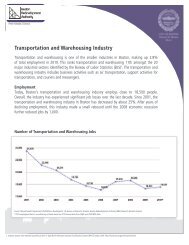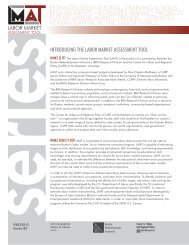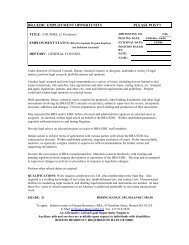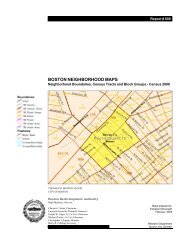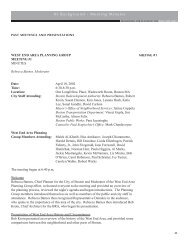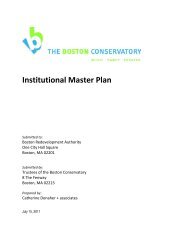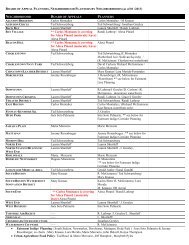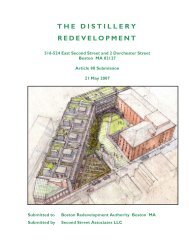Draft Project Impact Report - Boston Redevelopment Authority
Draft Project Impact Report - Boston Redevelopment Authority
Draft Project Impact Report - Boston Redevelopment Authority
Create successful ePaper yourself
Turn your PDF publications into a flip-book with our unique Google optimized e-Paper software.
Overview<br />
<br />
Exeter Residences/888 Boylston<br />
Methodology<br />
\\Mabos\projects\09916.00\docs\Permits\DPIR\Text\DPIR Chapter 5<br />
Environmental.docx<br />
Major buildings, especially those that extend above their surrounding, often cause<br />
increased local wind speeds at the pedestrian level. Typically, wind speeds increase<br />
with elevation above the ground surface. Taller buildings intercept these faster winds<br />
and deflect them down to the pedestrian environment. The funneling of wind<br />
through gaps between buildings and the acceleration of wind around corners of<br />
buildings may also cause a localized increase in wind speed. Conversely, if a<br />
building is surrounded by others of equivalent height, it may be protected from<br />
prevailing upper-level winds, resulting in no substantial changes to the local<br />
pedestrian-level wind environment. The most effective way to assess potential<br />
pedestrian-level wind impacts around a proposed new building is to conduct scale<br />
model tests in a boundary layer wind tunnel. For that reason, RWDI has conducted<br />
the wind tunnel tests which are reported in this section.<br />
The consideration of wind in planning outdoor activity areas is important since high<br />
winds in an area tend to deter pedestrian use. For example, winds should be light or<br />
relatively light in areas where people would be sitting, such as outdoor cafés or<br />
playgrounds. For bus stops and other locations where people would be standing,<br />
somewhat higher winds can be tolerated. For frequently used sidewalks, where<br />
people are primarily walking, stronger winds are acceptable. For infrequently used<br />
areas, the wind comfort criteria can be relaxed even further. The actual effects of<br />
wind can range from pedestrian inconvenience, due to the blowing of dust or other<br />
loose materials in a moderate breeze, to severe difficulty with walking due to the<br />
wind forces on the pedestrian.<br />
Information concerning the site and surroundings was derived from site<br />
photographs, the BRA’s 3D model of the area, information on surrounding buildings<br />
supplied by the architects and site plans and elevations of the proposed development<br />
provided by the design team.<br />
The following configurations were simulated in the wind tunnel:<br />
Existing Conditions – includes existing buildings on and around the site;<br />
155-Feet Zoning Height – includes Exeter Residences and 888 Boylston at 155<br />
feet zoning height on and around the existing site surroundings.<br />
Proposed Program – includes the design of 28 stories and 320’ in height for<br />
the Exeter Residences and 19 stories and 265’ in height for 888 Boylston in<br />
and around the existing site surroundings.<br />
DRAFT - Environmental Protection 5-4



